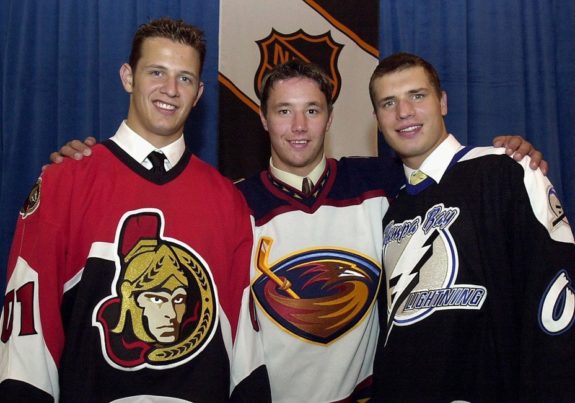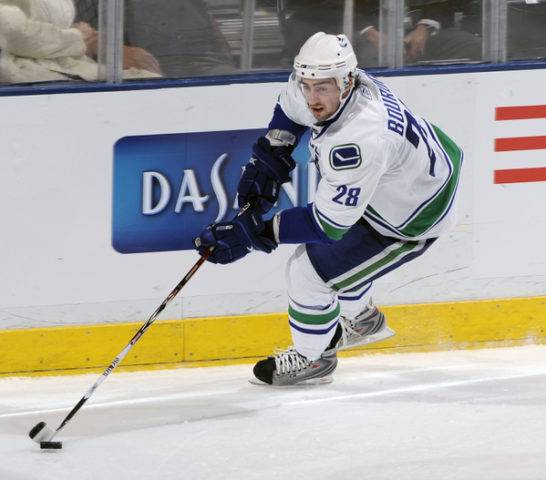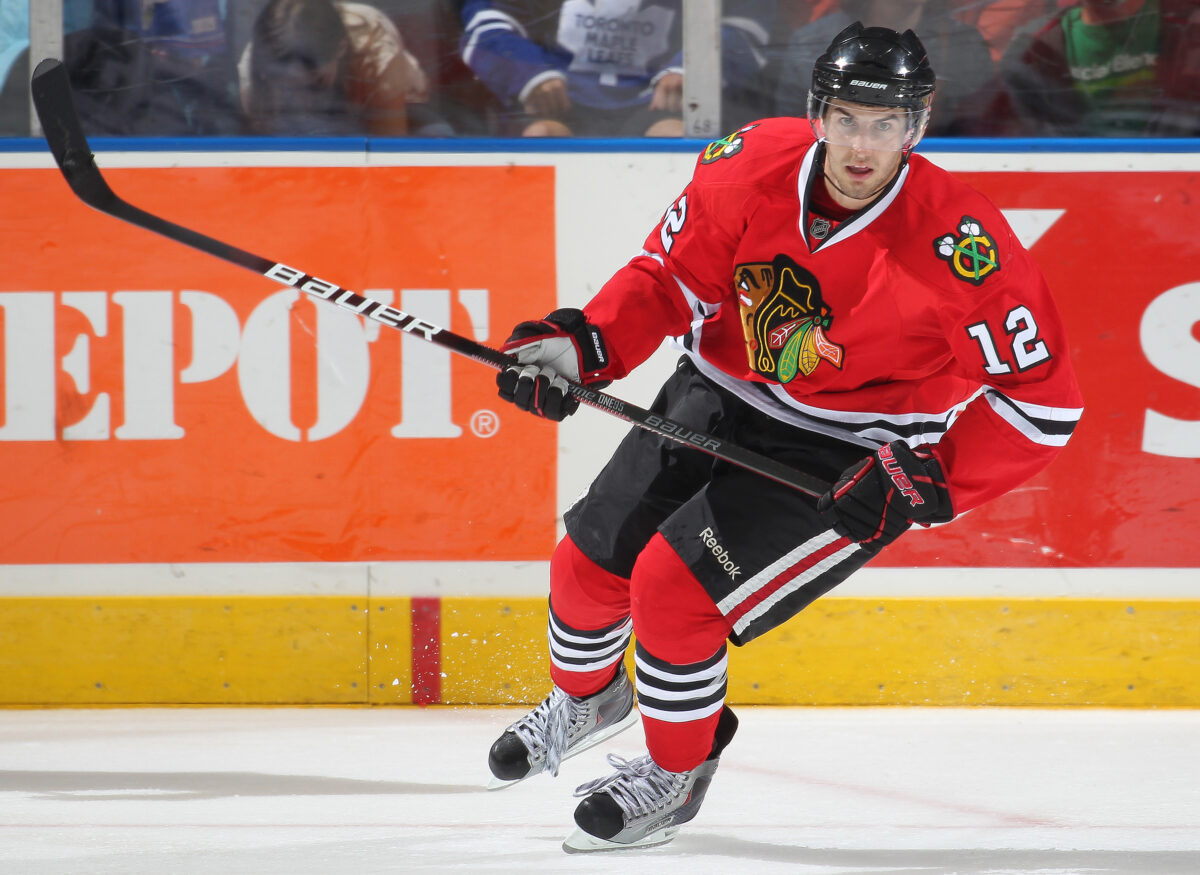If there’s one thing that’s true about every single NHL Draft, it’s that some highly-touted prospects won’t pan out. It’s the risk of selecting 18-year-olds with years of development ahead of them; at such a young age, a million things can prevent them from reaching their goals. Sometimes it’s the attitude, playing with a poor team, failing to respond to the increased pressure, or simply not having the skill set to play at the highest level. Whatever the reason is, they still all get called the same thing – a draft bust.
Take a look at Alexander Svitov, for example. Selected third overall in 2001 behind Ilya Kovalchuk and Jason Spezza, who both went on to have excellent NHL careers, the Tampa Bay Lightning only got a season and a half from the Russian star before trading him for practically nothing to the Columbus Blue Jackets. He lasted two more seasons before returning to Russia, where he played until 2021-22. Had the Lightning re-done the draft, they might have taken Mikko Koivu instead, who went sixth overall to the Minnesota Wild, or maybe Tomas Plekanec, who wasn’t picked until the third round.

However, Svitov’s story is far from simple. A highly-touted power forward from Siberia, the 6-foot-3 forward made his debut in Russia’s top league as a 16-year-old in 1998-99 and was already seen as an NHL-ready prospect on draft day, but when he signed his contract with the Lightning, he returned to Russia for the summer. That’s when he was reportedly informed that he had to serve two years in the military and was subsequently suspended from his team in Avangard. The Lightning quickly tried to rectify the situation, hoping to get their top prospect over for the 2002-03 season instead, but in the meantime, the Russian media was accusing the teenager and his family of being greedy for taking a job in the NHL.
It’s no wonder, then, that Svitov burned out quickly after arriving in North America, and he’s far from the only prospect who underwent incredible stress and trauma settling into their professional hockey career. Dozens of highly-touted draft picks have fizzled out before they hit their stride and were simply tossed aside as another draft bust. But there’s more to their stories than meets the eye. Looking back at the 2000-09 NHL Drafts, here are six more players that don’t deserve to be called a draft bust.
Rick DiPietro
Today, Rick DiPietro is viewed as a colossal failure by the New York Islanders, who selected him first overall in 2000. But very little of his fall from grace had to do with him; the team around him lacked talent thanks to a terrible general manager, and the intense pressure and impatience that followed him led to a series of injuries that eventually forced him to retire in 2013-14.
Taking DiPietro first overall was not a bad pick by any means. As a freshman with Boston College, he claimed Hockey East’s Rookie of the Year, New England’s Most Valuable Player, and was named the best goalie at the 2000 World Junior Championships after posting a 1.81 goals-against average over five appearances. But what made him a truly elite prospect was his ability to handle the puck and challenge shooters, similar to Martin Brodeur, who led the New Jersey Devils to Stanley Cup Championships in 1995, 2000, and 2003.
But the Islanders didn’t realize that they needed more than a goalie to win games. Just before making the pick, they shipped out both Kevin Weekes and Roberto Luongo, their two best goalies, in separate deals, and a year later, traded away Zdeno Chara and the second overall pick in 2001 for the temperamental star Alexei Yashin. Bit by bit, the Islanders tore apart their roster, adding aging veterans and role players, leaving DiPietro as one of the only bright spots on the team.
By 2006-07, DiPietro had emerged as one of the NHL’s better up-and-coming goalies after a rocky start in the league. But then the Islanders’ put the final nail in his proverbial coffin, signing him to the league’s longest contract ever, a 15-year deal that would keep him under contract until he was 40 years old. At first, the incredibly risky move seemed like it may pay off, as he was selected to the 2008 All-Star Game, but then the injuries hit. From 2008-2013, he played more than 10 games in a season just once, appearing in 26 contests in 2010-11, so the Islanders decided to cut ties with him, buying him out on July 3, 2013. He attempted to come back the season after with the American Hockey League’s (AHL) Charlotte Checkers, but the injuries had taken their toll, and he opted to retire in 2013-14.
Dan Blackburn
When the New York Rangers stepped up to the podium at the 2001 Draft, they were desperately in need of a new franchise goalie. Mike Richter was not the goalie he once was, and neither Guy Hebert nor Kirk McLean had been viable stopgaps. Their choice to replace him was Dan Blackburn, a highly touted goalie playing with the Western Hockey League’s (WHL) Kootenay Ice who instantly became their goalie of the future. While the hype around him was massive, he didn’t disappoint, making the team out of training camp as a 19-year-old and starting 31 games, which earned him a spot on the NHL All-Rookie and Young Stars teams.
The following season Blackburn played 32 games, and although his .890 save percentage was lower than expected, he had all the makings of a top-tier goalie, and much was expected from him in 2003-04. But just before the Rangers’ training camp opened, he pulled a muscle in his shoulder while weightlifting. Initially, he thought nothing of it, but he managed only a few preseason games before being forced to the sidelines, the pain in his shoulder unbearable whenever he lifted his arm. So he was placed on the injured reserve in hopes that the issue could be resolved.
Unfortunately, further tests revealed it wasn’t a pulled muscle, but that Blackburn has suffered nerve damage in his shoulder. He sat out the entire 2003-04 season, undergoing multiple surgeries to restore full movement in his arm and hand, but nothing worked. He even attempted a comeback in 2004-05 wearing two blockers, but it did little good and after 12 games he was forced to retire at the age of 22. He’s remained in hockey circles, running youth goaltender camps, as well as appearing in the 2011 NHL Alumni game against the Philadelphia Flyers. But playing competitively is all but impossible for the former first-round pick, as he still is unable to fully use his left hand.
Luc Bourdon
The 2005 Draft class is one of the deepest in NHL history. Headlined by Sidney Crosby, arguably one of the best players of all time, the first round also included future all-stars Bobby Ryan, Carey Price, Tuuka Rask, Marc Staal, T.J. Oshie, and Anze Kopitar. However, despite the depth, not everyone panned out. Right before the Los Angeles Kings snapped up Kopitar 11th overall, the Vancouver Canucks looked to bolster their defence for the foreseeable future and selected Luc Bourdon from the Quebec Major Junior Hockey League’s (QMJHL) Moncton Wildcats.

Bourdon made his professional debut in October 2006, playing nine games for the Canucks before returning to the QMJHL, looking every bit like a future two-way top-pairing defender, demonstrating an incredible work ethic and fantastic skating skills. He returned to the NHL in 2007-08, playing 27 games across multiple call-ups while spending most of the season with the American Hockey League’s (AHL) Manitoba Moose, where he had 14 points in 41 games. His first NHL goal came in November that year against the Minnesota Wild, and he scored again in January, this time against the Tampa Bay Lightning.
At the end of the 2007-08 NHL season, he returned home to New Brunswick and got his motorcycle license, buying a motorbike shortly after. He had it just two days before colliding with a truck, killing him on impact. His death rocked the local community, as he had been a hero to many from there who saw him as a small-town kid who broke through to the biggest stage in the hockey world. But it was also devastating for the Canucks and the many people he impacted along the way. Bourdon is remembered as a skilled hockey player whose career was cut way too short, but also a passionate, caring person who stuck up for his friends.
Alexei Cherepanov
Alexei Cherepanov was hailed as one of the most talented prospects of his class heading into the 2007 Draft. He topped NHL Central Scouting’s list for European Skaters, ranking ahead of Mikael Backlund, Lars Eller, and Simon Hjalmarsson, and scored 18 goals to set a rookie record in Russia, surpassing Pavel Bure, Alex Ovechkin, and Evgeni Malkin. Although he was expected to be a top-10 selection at the very least, the lack of a transfer agreement between the Russian league and the NHL caused him to fall to the 17th pick, where the New York Rangers scooped him up.
Video scouting wasn’t what it is today, and many fans and scouts hadn’t been able to see the ‘Siberian Express’ play, but those who had were ecstatic over his potential as one of the most purely talented prospects of his draft class. Unfortunately, that potential was never realized. Cherepanov returned to Russia for the 2007-08 season, where he put up very similar totals to his rookie season. He remained in his home country for 2008-09, and the Rangers were hopeful they could bring him to North America for the following season, but in October, just 15 games into the season, the 19-year-old winger collapsed on the bench during a game. Team medics were unable to revive him and he died before an ambulance was able to pick him up.
After his death, it was revealed that Cherepanov had suffered from chronic ischemia, a syndrome in which there is a deficient blood supply to certain areas of the body. In the young Russian’s case that day, it was his heart. Whether his club knew about the disease is difficult to say, as reports differ, but there’s no question that the tragedy rocked the franchise. Avangard Omsk retired his No. 7, and the league named their Rookie of the Year Trophy after him. Furthermore, the Kontinental Hockey League (KHL) was forced to re-evaluate its medical practices, ensuring that nothing like that ever happened again.
Cody Hodgson
Three years after the selection of Bourdon, the Canucks were once again in possession of the 10th overall pick. The team likely didn’t expect to be in the same position so soon, but they weren’t worried; their core was in place, and just needed a season or two to generate some momentum. So, armed with another high pick, they looked for character and intelligence, which led them to one of the best in both areas, Cody Hodgson.

After another dominant year in the Ontario Hockey League and at the 2008 World Juniors, Hodgson looked ready to challenge for an NHL roster spot, but during the summer of 2009, he ended up injuring his back. Initially, it was assumed it was a disc injury and that he’d be ready for training camp in September, but months passed and he was unable to return to the ice. During that time, he began earning a reputation as someone who was challenging to deal with and blamed everyone else for his problems, which led to a fractured relationship with the Canucks.
Related: Cody Hodgson: A Promising Career Cut Short
It wasn’t until April 2010 that it was discovered that the talented center had torn a muscle in his back, and by then, the Canucks were seemingly tired of him recovering, so they shipped him and another player off to the Buffalo Sabres for Zack Kassian and another defenceman. It had little to do with his skill; after 63 games in Vancouver, he had 16 goals and 33 points, which put him in the running for the Calder Trophy as the league’s best rookie. But his reputation had been sullied by both coach and general manager, so he had little choice but to start fresh.
Hodgson played well in his first season with the Sabres, but soon old issues cropped up again and he was bought out, which allowed the Nashville Predators to sign him to a one-year deal. Back injuries continued to plague him, and finally, he found out the reason why – he discovered he had malignant hyperthermia (MH), a degenerative condition that produces rigidity in muscles, along with coronary stress. At just 26 years old, he was no longer able to play hockey and was forced into retirement. However, given that many people with the disease are wheelchair-bound, he says he still feels blessed for the career and life he’s had.
Kyle Beach
In 2008, Kyle Beach was seen as one of the best young power forwards in the game. In his draft year, he scored 27 goals and 60 points in 60 games while putting up 222 penalty minutes. Standing 6-foot-3 and already weighing over 200-pounds as a teenager, his potential seemed sky-high. Some sources saw him as a top-five pick in a draft stacked with elite defencemen, so when the Chicago Blackhawks stepped up to the stage with the 11th overall pick, they were more than happy to grab him.
Beach quickly emerged as the Blackhawks’ top prospect, leading the WHL with 52 goals in 2009-10 and being named to the league’s first All-Star team. After an early exit from the playoffs, he turned pro, joining the AHL’s Rockford Icehogs and practicing with the Blackhawks on their Stanley Cup run. With a few games under his belt in the minors, he was expected to join Chicago for the start of the 2010-11 season, but suddenly, the power forward looked completely different. He had a poor training camp and was re-assigned to the Icehogs, where he remained until 2013. After that, he left to play in Europe, finishing his career in Germany in 2022.

Fans were dumbfounded how their team’s best prospect could go from an all-star to a nobody in a single season, and more than a few sources considered him the Blackhawks’ worst draft bust ever. However, in 2021, details were revealed that put everything into context. During that 2010 run, Beach had a non-consensual encounter with video coach Brad Aldrich that left him feeling scared and alone. But what was even worse was that when the incident was reported, the team did practically nothing, leaving Beach broken. “It made me feel like I didn’t exist. It made me feel like he was in the right and I was wrong.”
It’s no wonder that Beach’s NHL career fell apart after 2010. He no longer felt welcome in an organization that valued his abuser over him, and soon he was labelled as lazy, self-involved, and problematic. Thankfully, some restitution has come around for Beach, as he agreed to a confidential settlement in December with the team, and both Stan Bowman and John Quenneville, the general manager and coach of the 2010 Blackhawks, have stepped down from their respective roles. He’s also taken time to address the investigation, hoping that by speaking up, he’d help someone else going through what he did, because no one should have to go through that experience.
A Career Cut Short
The 2000s are often seen as one of the best eras in drafting in NHL history thanks to the increased focus on scouting as well as a bigger emphasis on off-season training and diets. Young players were more prepared to play in the NHL than ever before, resulting in fewer high-end draft busts than in the previous decade. So, when it comes to players considered busts, it seems far more likely that they were prevented in some way from reaching their goal, whether that be due to injuries or other circumstances than simply being ‘not good enough.’
Of course, injuries are a part of hockey. Many players have been forced into retirement because their bodies cannot keep up with the intensity of professional hockey. Bobby Orr, Cam Neely, Mike Bossy, and Pavel Bure are just a few of the stars of yesteryear who could have had incredible careers had injuries not cut their playing time short. But at least those players got to make a career in the NHL before injuries took over. When a prospect or young player is forced into early retirement, critics are relentless, rarely giving them a second thought until more details about their lives and playing days are revealed. Many more than these six have been subject to unthinkable trials before the age of 25, and fans should think twice before labelling them nothing more than a bust.